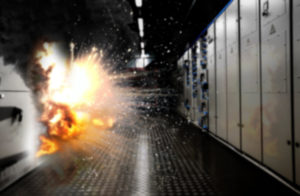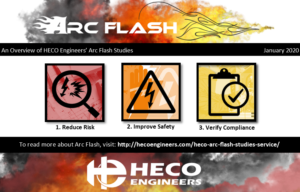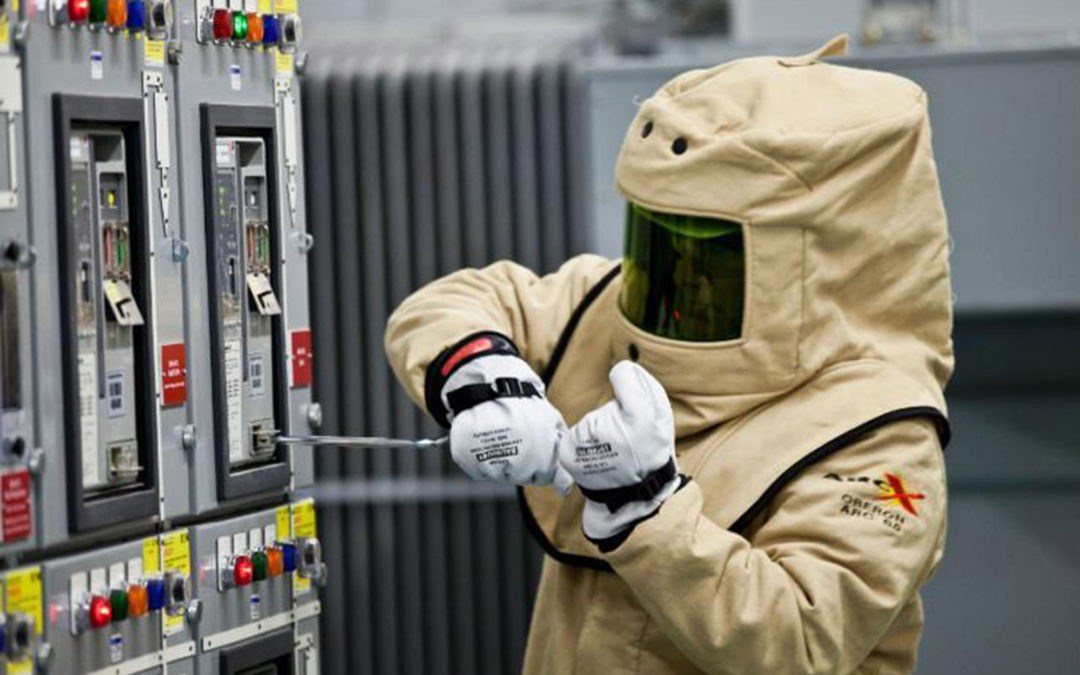Case Study: The Importance of Arc Flash Studies in Industrial and Commercial Power Systems
The following content presents a case study exploring the significance of arc flash studies in the context of industrial and commercial power systems. It delineates the inherent challenges related to electrical hazards and regulatory compliance that businesses face.
The case study further discusses the solution provided by HECO Engineers, who have developed a unique, three-phased approach to conduct comprehensive, cost-effective arc flash studies. The goal of this study is to highlight how a strategic, data-driven approach can enhance workplace safety, fulfill regulatory requirements, and promote operational efficiency in high-risk environments.
Problem: Power Systems Present Inherent Risks

Arc Flash Explosion- it could happen to you.
Industrial and commercial power systems present inherent risks, notably electrical shocks and arc flash incidents, which can result in severe injuries, equipment damage, and even fatalities. The Occupational Safety and Health Administration (OSHA) emphasizes the necessity of workplace hazard assessments, including arc flash studies, for worker protection. However, conducting these studies in a cost-effective, comprehensive, and customizable way remains a challenge for many organizations.
Moreover, businesses are required to comply with the National Fire Protection Association (NFPA) 70E standards and OSHA regulations. Failure to meet these mandates can lead to legal liabilities and damages to a company’s reputation. Consequently, a reliable and efficient approach to arc flash studies is indispensable to maintaining operational efficiency, ensuring compliance, and safeguarding the well-being of the workforce.
Solution: Three-Phased Approach to Arc Flash Studies
 HECO Engineers, recognizing the significance of this challenge, devised a three-phased approach to arc flash hazard studies to cater to clients’ unique needs and budgets. Arc flash analysis assessments play a pivotal role in reducing risks and enhancing workplace safety. By conducting a comprehensive study, businesses gain valuable insights into potential energy hazard levels that could be encountered during work on or around energized electrical equipment.
HECO Engineers, recognizing the significance of this challenge, devised a three-phased approach to arc flash hazard studies to cater to clients’ unique needs and budgets. Arc flash analysis assessments play a pivotal role in reducing risks and enhancing workplace safety. By conducting a comprehensive study, businesses gain valuable insights into potential energy hazard levels that could be encountered during work on or around energized electrical equipment.
The result of the assessment is the installation of labels on electrical gear, disclosing the required PPE to safely operate in these environments. In addition to protecting employees from harm, arc flash studies fulfill crucial NFPA 70E and OSHA compliance requirements, safeguarding businesses from legal liabilities.
This strategy offers a practical and effective solution to the outlined problem.
Phase 1: Comprehensive Site Assessment
A comprehensive site assessment is conducted. Key electrical system data are collected, including transformer details, conductor types, fuse and circuti breaker data and available fault current. This data collection ensures a detailed and accurate evaluation of the client’s site.
Phase 2: Sophisticated software analysis
Sophisticated software analysis is applied for data evaluation, resulting in precise electrical one-line diagrams, equipment condition assessments, short circuit analysis, incident energy analysis and practical safety recommendations. This phase helps businesses understand the state of their electrical systems and potential energy hazards, allowing for informed decision-making.
Phase 3: The Implementation of a Safe Practices Program
The implementation of a Safe Practices Program is prioritized. This involves the generation of Arc Flash labels, which specify the required Personal Protective Equipment (PPE) for safe operation around energized electrical equipment. Additionally, comprehensive training on appropriate PPE usage is provided, enhancing employee understanding and adherence to safety protocols.
Outcome: Identification of Potential Electrical Hazards & Education
 HECO Engineers’ approach not only identifies potential electrical hazards but also equips employees with the necessary knowledge and tools to navigate these risks safely. It ensures compliance with NFPA 70E and OSHA regulations, thereby protecting businesses from legal liabilities.
HECO Engineers’ approach not only identifies potential electrical hazards but also equips employees with the necessary knowledge and tools to navigate these risks safely. It ensures compliance with NFPA 70E and OSHA regulations, thereby protecting businesses from legal liabilities.
By implementing the recommendations from HECO Engineers’ arc flash studies, companies have reported reduced downtime and improved operational efficiency. Additionally, these businesses have fostered a culture of safety and responsibility, demonstrating their commitment to employee well-being.
This comprehensive solution from HECO Engineers supports organizations in creating a safer, more resilient work environment. It underscores the importance of prioritizing employee safety, compliance with regulations, and operational efficiency in industrial and commercial power systems.
For more information about HECO Engineers’ experts and services, please visit www.hecoengineers.com or call (208) 642-3304.
Conclusion for Mitigating Power System Risks
In the face of potentially devastating electrical hazards, HECO Engineers offers an effective, customizable solution to arc flash studies. This approach not only mitigates risks but also promotes a culture of safety, leading to a safer and more resilient work environment.
Click here to view more HECO Engineer projects.
Phone: (208) 642-3304
Web: https://hecoengineers.com/
HECO Corporate Office: 32 N Main St. Payette, ID 83661
HECO Nampa Office: 5700 E Franklin Rd, Suite 160 Nampa, ID 83687
Frequently Asked Questions
The following Frequently Asked Questions (FAQs) serve as a guide to understanding arc flash hazards and their implications in industrial and commercial power systems. Whether you’re an employer, an employee, or a safety officer, these FAQs aim to shed light on the nature of arc flash incidents, the importance of arc flash studies, and the role of regulatory bodies in maintaining workplace safety.
1. What is an arc flash hazard?
An arc flash hazard is a dangerous release of energy caused by an electric arc. It can result in severe burns, injuries, and even fatalities.
2. Why are arc flash studies important in industrial and commercial power systems?
Arc flash studies are important to assess the risk associated with potential arc flash hazards in electrical equipment. They help in determining necessary safety measures and ensuring compliance with regulations.
3. What is the significance of performing arc flash analysis?
Arc flash analysis involves studying the electrical system to calculate the incident energy levels and determine the appropriate Personal Protective Equipment (PPE) required to protect workers from arc flash hazards.
4. How does NFPA 70E relate to arc flash studies?
NFPA 70E is a standard established by the National Fire Protection Association (NFPA) that provides guidelines for electrical safety in the workplace, including requirements for arc flash studies and PPE.
5. Why is PPE important in arc flash situations?
PPE is essential in arc flash situations as it provides the necessary protection against thermal energy and potential hazards associated with an arc flash incident.
6. What is the role of OSHA in arc flash safety?
OSHA (Occupational Safety and Health Administration) sets safety standards and regulations to protect workers from hazards, including arc flash incidents. Compliance with OSHA regulations is crucial in maintaining workplace safety.
7. How can arc flash incidents be prevented?
Arc flash incidents can be prevented by implementing proper work practices, conducting regular arc flash studies, ensuring equipment is properly maintained, and providing adequate training to electrical workers.
8. What are some common causes of arc flash incidents?
Common causes of arc flash incidents include equipment failure, incorrect work procedures, human error, equipment malfunctions, and electrical system faults.
9. What is the importance of electrical system studies in arc flash hazard assessment?
Electrical system studies, such as power system studies, help in identifying potential arc flash hazards, assessing fault currents, and determining the incident energy levels. These studies aid in developing effective arc flash hazard mitigation strategies.

